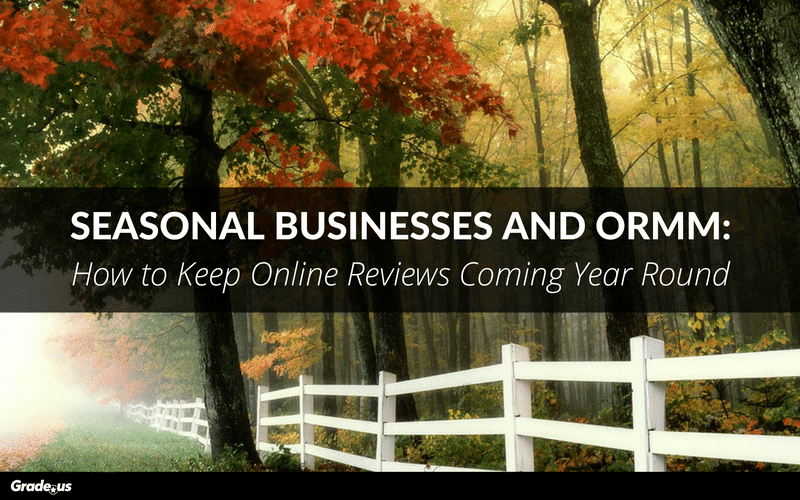Your clients have a problem. It’s their off season. The time when business slows down and customers stop calling. Landscapers, ice cream parlors, summer camps, ski resorts — seasonal businesses go through this every year.
The problem isn’t really the off season though, is it? It’s the next season. It can be tough to get things going again, to get customers back into a routine. Sometimes clients find they’ve lost customers in the off season – customers go in a different direction, handle things in-house, etc.
These unexpected changes create fear.
It’s common for businesses to start their season with a twinge of uncertainty and fear. “What will this season be like? Business was slow last year.” Established businesses are so confident things will go well, they’re surprised when they don’t.
Then panic sets in.
What if your clients were able to create the kind of demand they needed to start their season confidently? What if they were able to prime their customers, starting their season with a list of customers who are ready-to-buy?
Reviews make that happen.
But these reviews need a specific ingredient in order to maximize impact. Research shows 90 percent of customers say their buying decisions are influenced by online reviews. But a small minority, 1.5 percent in some industries, actually create reviews.
There’s another problem.
Customers forget.
Customers in the research process forget about the providers they find, which usually means these customers are lost opportunities.
The right ingredient keeps customers focused.
Customers need consistency and reminders to keep your business top of mind. A great review pushes them over the edge – “I need to buy this” they tell themselves. Until they forget, which usually means you’ve lost them forever.
Consistency is your secret ingredient.
Let’s pretend for a moment that you’re running a ski resort. For most people a ski resort is a group activity. Most people don’t go skiing alone unless they’re an enthusiast.
But going with a group takes planning and work. Schedules have to be aligned, logistics have to be worked out. People do this with friends all the time, but the stakes are higher.
It’s more important that people choose the right place. Objections take priority. Groups are more likely to rule out resort locations that can’t address the objections that are raised.
But that’s what great reviews do.
It’s not enough to simply answer the objections yourself. It’s better if a customer does it for you… with a five star review. Positive reviews addressing specific aspects of your business will help defuse objections.
A consistent stream of positive reviews primes customers, preparing them for next season. When ski season rolls around customers are conditioned and ready to buy.
But that’s part of the problem, how on earth do you keep reviews coming in year round? It’s tough enough for businesses that operate all year.
It’s simple if you take things one step at a time.
The first step is accepting the ugly truth.
Customers don’t want to give reviews. Most clients approach the problem directly. “Enjoyed our service? Write us a review.” Customers are accustomed to receiving requests to write reviews.
What’s the problem with this approach? There’s nothing in it for them. The reviews that clients get with this approach are weak. They lack power which means they won’t accomplish what they’re supposed to.
Defuse objections and reduce risk.
Then, there’s the review itself. Most customers aren’t sure what to say or how to say it. This means they’re more likely to give a review that’s nothing more than fluff. Or they leave a 5 star review ignoring anything that explains their experience. These obstacles make reviews an uphill battle for customers, making year round reviews an unlikely scenario.
Fix these problems and you’ll get the high quality reviews you need. But how do you get off season reviews in the first place? It’s simple, you ask for them.
Tactic 1: Reach out to negative reviewers
If you’re in business, you’re bound to have a few negative reviews. Customers aren’t always happy with the work we do; sometimes we make mistakes. Sometimes things don’t go the way we plan.
So you do your best to make things right. You find out what happened and you make things right. But what then?
It’s common for businesses to treat those customers as a lost cause. “I screwed up, they’re gone forever.” But what if these customers weren’t gone forever? What if there was a chance you could win them back and win new customers over in the process?
Here’s how you do it.
- Create a list of negative reviews. You’re looking for any customers who had a legitimate problem or concern and left a negative review. Serious or previously engaged customers are ideal.
- Segment your list. Go through each review eliminating trolls, ragers, sadists and abusive customers. Avoid these customers unless you have a clear plan of action.
- Create an irresistible offer to entice customers;. If you’re running a ski resort you could reach out to unhappy customers with a free 10 day pass good for 10 people.
- Pitch unhappy customers. Approach each of the customers who meet your criteria. Make it clear that you’re looking to make things right.
- Make their experience memorable doing what it takes to fix the problems they mentioned in their review. Roll out the red carpet, ensure staff is on their best behavior. Do what you can to restore the relationship.
Here’s the most important part of this strategy. Ignore this step and everything falls apart.
You’ll want to do this as your season comes to a close.
This means it’s important to time things well. Think about the time it typically takes you to get a review from customers; if it takes 30 to 90 days, you’ll need to plan things out well in advance. 5 to 10 days obviously requires less planning.
Be sure to factor in travel times, planning and logistics as customers will need time to plan things out.
Tactic 2: Relive happy memories with customers
The vast majority of your happy customers haven’t given you a review. They haven’t shared their views, opinion or experience with you. If you’re looking for positive reviews you can reach out to each of your happy customers and ask them to share.
But customers hate writing reviews, remember?
Why would customers write a review for you? It’s simple, you’re going to use the review to give them something they want. So what do customers want in exchange for a review?
- Creating an image. Making conversation, improving status or building prestige; becoming a hero or influencer, perception sculpting, etc.
- Regulating emotions. Venting, attracting support, revenge, making sense of things, reducing cognitive dissonance, etc.
- Getting information. Seeking advice, requesting a referral, looking for help with a specific problem, etc.
- Bonding with others. Reinforcing shared viewpoints and beliefs. Counteracting loneliness and isolation.
Use these angles to frame your request and customers are more likely to share.
What if they don’t know what to say? What if they write a terrible review? You can decrease your odds of disaster by guiding customers with questions.
- What would have prevented you from buying?
- What did you find as a result of buying this?
- What did you like most about our product (or service)?
- What would be three other benefits to this product (or service)?
- Would you recommend this to someone else? Why?
These questions give customers a clear track to follow. When customers answer these questions they can’t help but share a believable, credible review that defuses objections.
So when do you ask happy customers for a review?
The obvious answer is asking after the sale and ideally face to face. But most customers aren’t as quick to share, are they? So, you ask happy customers again as the next season approaches, using their motivations as an incentive. Begin asking for reviews before your season starts. Ask the right way and response rates go way up.
Hi Anne,
I’m reaching out to our top 3% customers (you’re one of them :)). I had six questions I wanted to ask. Should only take 4 or 5 minutes.
Would it be alright if we talked on the phone? I’m free tomorrow at noon.
Andrew
Then, when customers agree to the call, get their permission to record it. Transcribe the call, then email it to them along with a link to the review site you’d like them to post it to.
Ask them to copy and paste their feedback into the form and viola! You have a review. Need to handle a large volume of calls? Send customers to a dedicated voicemail inbox, and ask them to share their thoughts. Follow the same steps as before.
Use these tactics to keep reviews coming in year round.
Off season reviews aren’t important
Customers aren’t interested in landscaping during the winter. Ski resorts aren’t attracting customers in the summer. Reviews aren’t as important in the off season, right?
Customer interest dips when the off season starts. Which is exactly why that’s the best time to deal with negative reviews. If customers are paying attention, you win. If they’re not paying attention, you win.
As the off season drags on, their interest begins to grow, they begin to think about the start of their season. They begin thinking about the work that needs to be done. Which is the perfect time to share lots of good news with customers.
The off season doesn’t have to be a problem
The offseason is a time when business slows down and customers stop calling. It’s something thousands of businesses go through every year.
The off season doesn’t have to be a problem. Next season shouldn’t start with a dry spell. It’s tough for others to get things going again, to get customers back into the swing of things.
Your ORMM strategy goes hand-in-hand with your advertising. Both work together to attract and retain customers. Established businesses are confident things will go well, and they do – because they have a plan. Some clients lose customers consistently in the off season, not you.
You’re ready for the upcoming season, you’ve followed your plan. Your customers are primed, ready and eager-to-buy.
About the Author
Andrew McDermott
Andrew McDermott is the co-founder of HooktoWin. He shows entrepreneurs how to attract and win new customers.











